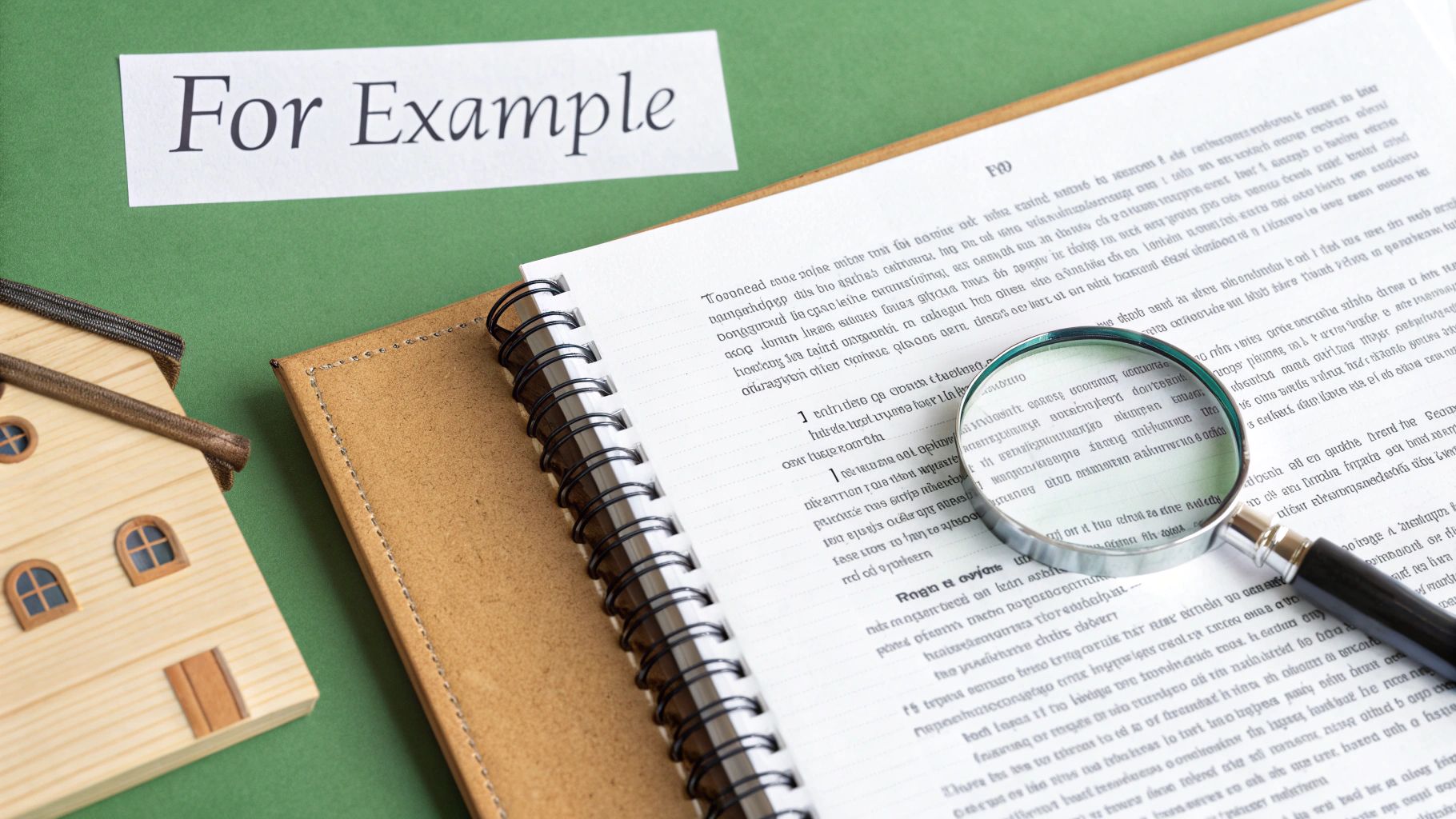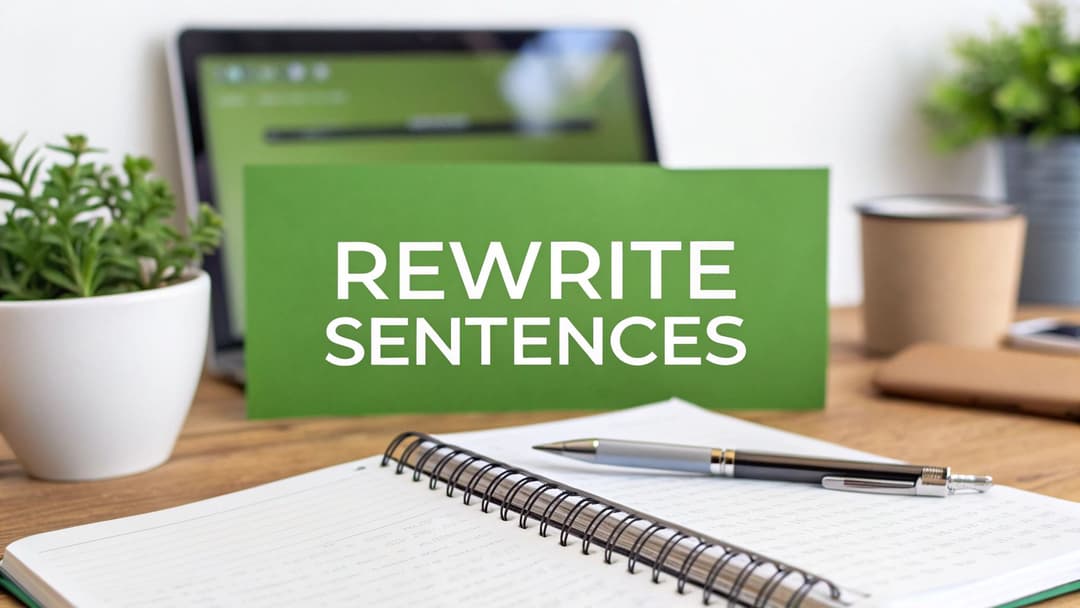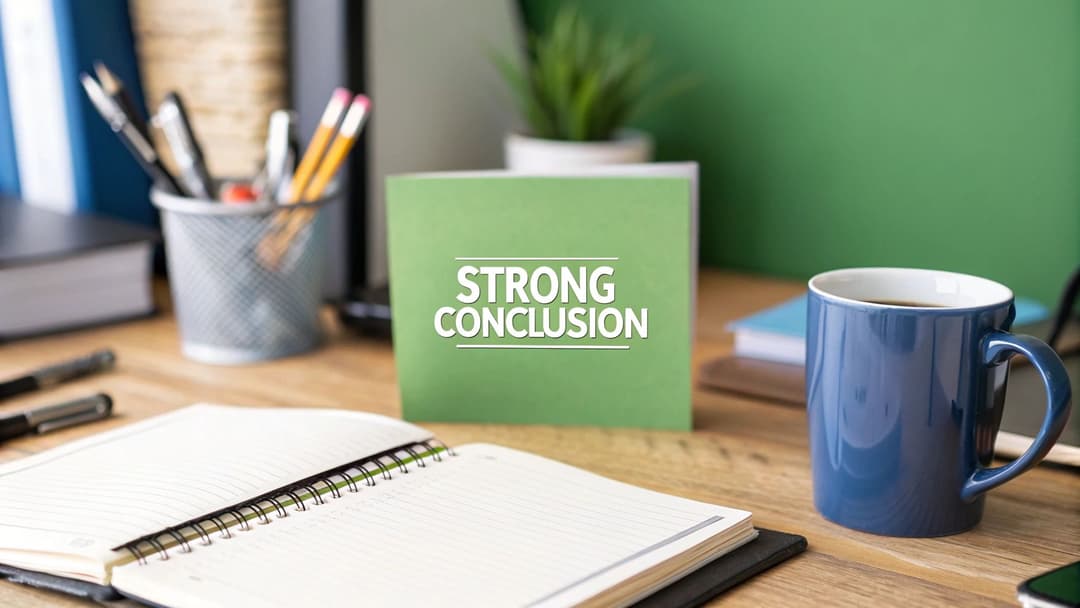
10 Key Categories of Transition Words for Essays in 2025
November 1, 2025
Struggling to connect your ideas smoothly? You've crafted brilliant points, but they feel disjointed, like islands in a sea of text. The secret to bridging these gaps lies in mastering transition words for essays. These small but mighty words and phrases act as signposts, guiding your reader through your argument, ensuring your logic is clear, and transforming a good essay into a great one. They are the essential connectors that create a seamless and logical flow, making your writing more persuasive and professional.
This comprehensive guide moves beyond simple lists. We'll break down the most effective transition words into 10 distinct categories, from adding ideas and showing contrast to concluding your thoughts. For each category, you’ll find extensive lists, practical examples, and specific usage tips to help you choose the perfect word for any context. By implementing these tools, you can elevate your writing from choppy to cohesive. To further enhance the impact of your transition words and overall writing, utilizing writing tools like Grammarly can provide valuable feedback on style, grammar, and coherence. Prepare to unlock a new level of clarity in your work.
1. Additive Transitions: To Build and Expand Your Arguments
Additive transition words are the foundational building blocks for constructing a strong, layered argument in your essay. They signal to the reader that you are adding more information, evidence, or ideas that reinforce and expand upon the point you just made. Think of them as the "and another thing" connectors that create a seamless flow of related thoughts.
These transitions are crucial for stacking evidence and making your claims more robust. By using them, you show that your argument is not based on a single piece of information but is supported by multiple, interconnected details. This method of layering information is essential for building a convincing and comprehensive case.
Examples in Action
- Adding a similar idea: The initial marketing campaign successfully increased brand awareness. Additionally, it boosted social media engagement by 40%.
- Reinforcing a point: The study's methodology was fundamentally flawed. Furthermore, the sample size was too small to yield statistically significant results.
- Introducing more evidence: Deforestation contributes to habitat loss for countless species. Moreover, it accelerates the rate of climate change by reducing the Earth's capacity to absorb carbon dioxide.
How to Use Additive Transitions Effectively
To get the most out of these essential transition words for essays, follow these strategic tips:
- Vary Your Choices: Avoid repeatedly using "also" or "in addition." Mix in stronger alternatives like "furthermore" or "moreover" when introducing a more impactful point to keep your writing dynamic.
- Ensure True Connection: Only use an additive transition if the new information genuinely builds upon the previous sentence. The connection must be logical and relevant to your main argument.
- Placement is Key: For maximum clarity, place these transition words at the beginning of the sentence. This immediately signals your intent to the reader. These transitions work particularly well when introducing new evidence that supports your topic sentences for body paragraphs.
2. Causal/Consequential Transitions: To Show Cause and Effect
Causal or consequential transition words are the critical links that establish cause-and-effect relationships in your writing. They signal to the reader that one action, event, or idea directly leads to another outcome or consequence. Think of them as the "because of this, that happened" connectors that illuminate the logical progression of your arguments.
These transitions are vital for analytical and argumentative essays where explaining the "why" behind an event is just as important as describing the event itself. By using them, you clearly map out the chain of events for your reader, making complex relationships easy to understand and demonstrating your deep analytical thinking.
Examples in Action
- Showing a direct cause: Because of the prolonged drought, the region experienced severe agricultural losses.
- Highlighting a consequence: The company failed to adapt to market changes; consequently, it declared bankruptcy within a year.
- Linking reason to result: Due to a lack of funding, the research project was indefinitely postponed.
How to Use Causal Transitions Effectively
To masterfully integrate these transition words for essays, consider these strategic tips:
- Verify the Causal Link: Before using a word like "therefore" or "as a result," ensure a genuine cause-and-effect relationship exists. Do not confuse correlation with causation; one event happening after another does not mean it was caused by it.
- Vary Your Sentence Structure: Use phrases like "because of" and "due to" to embed causes within a sentence for tighter, more fluid writing. Place words like "consequently" or "therefore" at the start of a new sentence to give the resulting effect more emphasis.
- Strengthen with Evidence: A causal claim is only as strong as its proof. Always follow a causal transition with concrete evidence or data to substantiate the relationship you are asserting. This turns a simple claim into a powerful, fact-based argument.
3. Contrast/Contradiction Transitions: To Challenge and Differentiate
Contrast and contradiction transition words are essential tools for demonstrating critical thinking in your writing. They signal a shift in argument, introducing an opposing viewpoint, conflicting evidence, or a nuanced perspective. Think of them as the "but" or "on the other hand" connectors that introduce complexity and balance to your discussion.

These transitions are vital for acknowledging counterarguments, which strengthens your own position by showing you have considered multiple facets of an issue. Using them effectively allows you to build a sophisticated, well-rounded argument that goes beyond simple statements, showcasing a deeper analytical understanding of your topic.
Examples in Action
- Introducing an opposing view: Proponents claim the new law will stimulate economic growth. However, critics argue that it will disproportionately affect low-income families.
- Highlighting a different outcome: Although the initial experiments were promising, the final results failed to replicate the success.
- Showing an alternative: The first strategy focused on direct marketing. In contrast, the alternative approach utilized social media influencers to reach a wider audience.
How to Use Contrast Transitions Effectively
To master these powerful transition words for essays, apply the following strategic tips:
- Signal a Turn: Use words like "however," "conversely," or "on the other hand" at the start of a sentence to clearly signal an upcoming contradiction or counterpoint. This prepares the reader for a shift in perspective.
- Concede and Rebut: Employ transitions like "while," "although," or "despite" to acknowledge a valid point from an opposing view before immediately pivoting back to strengthen your main argument. For example: "While the counterargument has some merit, it overlooks a crucial piece of evidence."
- Maintain Balance: When presenting a counterargument, ensure it is represented fairly but concisely. The goal is to show you have considered it, not to give it equal weight to your own thesis, which should always remain the primary focus.
4. Chronological/Sequential Transitions: To Guide Your Reader Through Time
Chronological or sequential transitions are the signposts that guide your reader through a timeline or a step-by-step process. They organize information according to its order in time, making it easy for readers to follow a sequence of events, a historical narrative, or procedural instructions. Think of them as the "first this, then that" connectors that establish a clear, linear progression.
These transitions are indispensable for narrative essays, process analysis papers, and historical accounts. By using them, you create a coherent flow that prevents confusion and ensures the reader understands the relationship between events in the order they occurred. This temporal structure is fundamental to clarity in many forms of writing.

Examples in Action
- Narrating events: Initially, the company struggled to gain market share. Subsequently, it launched a viral marketing campaign that changed its trajectory.
- Providing instructions: First, preheat the oven to 350 degrees Fahrenheit. Next, mix the dry ingredients in a large bowl.
- Showing simultaneous action: The government was debating new regulations. Meanwhile, grassroots organizations were already implementing changes at the local level.
How to Use Chronological/Sequential Transitions Effectively
To master the use of these essential transition words for essays, consider these tips:
- Use Numbers for Clarity: For precise, step-by-step instructions, use ordinal numbers like "first," "second," and "third." This leaves no room for ambiguity.
- Vary Your Wording: Avoid the monotony of using "then" repeatedly. Alternate with words like "next," "afterward," and "subsequently" to keep your prose engaging.
- Indicate Simultaneous Events: Use "meanwhile" or "at the same time" to show two or more actions happening concurrently, adding complexity and depth to your narrative.
- Anchor the Sequence: Always place these transitions at the beginning of the sentence to immediately signal to the reader where they are in the sequence. This is a core component of a well-organized essay structure. Learn more about crafting a strong essay structure and see examples.
5. Clarification/Elaboration Transitions: To Explain and Simplify
Clarification transition words are your tool for ensuring the reader fully grasps complex ideas. They signal that you are about to restate, explain, or provide a concrete example of a point you just made. Think of them as the "let me put it another way" connectors that bridge the gap between an abstract concept and clear understanding.
These transitions are vital when dealing with technical subjects, dense theories, or nuanced arguments. By using them, you can unpack a complicated sentence, making your reasoning transparent and accessible. This approach prevents reader confusion and strengthens the overall persuasiveness of your essay.
Examples in Action
- Restating for clarity: The socioeconomic model operates on the principle of allocative efficiency. In other words, it aims to distribute resources in the most effective way possible.
- Providing a specific case: Many organisms have developed unique survival mechanisms. For instance, the chameleon changes its color to blend in with its surroundings.
- Narrowing the focus: The project faced several logistical challenges. Specifically, sourcing the rare materials proved to be a significant bottleneck.
How to Use Clarification Transitions Effectively
To master these crucial transition words for essays, consider these strategic tips:
- Choose the Right Tool: Use "for example" or "for instance" to introduce specific cases that illustrate a general statement. Use "in other words" or "to put it another way" when your original phrasing might be unclear or academic.
- Provide Genuine Elaboration: Ensure your clarification adds real value and doesn't just repeat the same information in a slightly different way. The goal is to deepen understanding, not just fill space.
- Combine with Concrete Details: The most effective clarifications are followed by tangible, specific details or examples that make the abstract point concrete and memorable for the reader. Using these transitions is a great way to vary your sentence structure and improve readability.
6. Comparison Transitions: To Highlight Similarities
Comparison transitions are used to highlight the similarities between two or more ideas, concepts, or pieces of evidence. Unlike contrast transitions that focus on differences, these words signal to the reader that you are about to draw a parallel, creating a bridge between two related points. Think of them as the "in the same way" connectors that build coherence by showing logical relationships.
These transitions are particularly valuable for strengthening an argument by demonstrating that a principle or observation holds true in multiple contexts. By drawing an analogy or showing a parallel, you can make a complex idea more relatable or prove that a pattern exists, which adds a layer of sophisticated analysis to your writing.
Examples in Action
- Drawing a parallel: The economic policies of the 1920s led to a market bubble. Similarly, many of the tech startups in the late 1990s were overvalued, leading to a similar collapse.
- Creating an analogy: Just as a foundation is crucial for the stability of a house, a strong thesis statement is essential for a coherent essay.
- Reinforcing consistency: The first study found a clear correlation between diet and health. Likewise, the second experiment produced consistent results under different conditions.
How to Use Comparison Transitions Effectively
To ensure these powerful transition words for essays clarify your argument rather than confuse it, follow these guidelines:
- Ensure a Valid Comparison: The most critical rule is to ensure the two things you are comparing share a genuine and significant similarity. A weak or forced analogy can undermine your credibility.
- Vary Your Language: While "similarly" is a reliable choice, using words like "likewise" or phrases like "in the same vein" can add variety and elegance to your prose.
- Follow with Evidence: After making a comparison, immediately provide the specific details or evidence that supports the similarity you've just claimed. Don't just state the parallel; prove it.
- Placement for Clarity: Like other transition types, comparison words are most effective when placed at the beginning of a sentence. This immediately prepares the reader for the parallel you are about to draw.
7. Emphasis/Importance Transitions: To Highlight Key Arguments
Emphasis transition words act as a spotlight, drawing the reader’s attention to the most critical points in your essay. They signal that a particular piece of information is of special significance and is central to your argument. Think of them as the verbal equivalent of underlining or bolding a sentence; they tell the reader, "Pay close attention to this."
These transitions are vital for persuasive writing, as they help you control the narrative and guide your reader’s focus. By strategically highlighting key evidence or claims, you can ensure your main points don't get lost in the details. They add weight and gravity to your most compelling ideas, making your overall argument more impactful and memorable.
Examples in Action
- Highlighting a critical finding: The experiment yielded several interesting results. Most importantly, it confirmed the hypothesis that the protein is essential for cell regeneration.
- Underscoring a significant fact: While many factors contributed to the economic downturn, crucially, the collapse of the housing market was the primary catalyst.
- Drawing attention to a key detail: The new policy will affect all departments. Notably, the marketing team will need to revise its entire Q4 strategy.
How to Use Emphasis Transitions Effectively
To harness the power of these transition words for essays, consider these strategic tips:
- Reserve for True Importance: Overusing emphasis transitions dilutes their power. Save words like "crucially" or "significantly" for the genuinely pivotal points of your argument, not for routine statements.
- Back It Up: An emphasized point must be followed by substantial evidence or strong reasoning. When you signal that something is important, you create an expectation that you will explain why it is important.
- Vary Your Placement: While often placed at the beginning of a sentence, these transitions can sometimes be placed mid-sentence for stylistic variation, as long as the clarity of the point is maintained. This ensures your writing remains engaging.
8. Concession Transitions: To Acknowledge and Overcome Counterarguments
Concession transition words are sophisticated tools for elevating persuasive writing. They signal that you are acknowledging a valid counterpoint or limitation to your argument before reaffirming its overall strength. Think of them as the "even though this is true, my point still stands" connectors that demonstrate intellectual honesty and critical thinking.
These transitions are invaluable in argumentative essays because they build credibility. By showing your reader that you have considered alternative perspectives and potential weaknesses, you present yourself as a thoughtful and balanced writer. This strategy preemptively addresses reader skepticism and makes your subsequent refutation more powerful and convincing.
Examples in Action
- Acknowledging an opposing view: Admittedly, the initial investment for renewable energy is high. Nevertheless, the long-term environmental and economic benefits are undeniable.
- Conceding a minor point: To be sure, the novel's pacing is slow in the first few chapters. However, this deliberate buildup creates a much more impactful climax.
- Granting a condition: Granted that the opposition presents a valid concern about privacy, the proposed security measures are designed to mitigate those specific risks.
How to Use Concession Transitions Effectively
To master these powerful transition words for essays, apply these strategic tips:
- Always Pivot Back: A concession must always be followed by a strong rebuttal or a return to your main argument, often using an adversative transition like "however" or "nevertheless." Never end a paragraph on the concession itself.
- Be Genuine: Acknowledge legitimate, real limitations or counterarguments. Conceding a weak or "straw man" point will undermine your credibility rather than enhance it.
- Keep It Brief: State the concession clearly and concisely. The focus should remain on your primary argument, so avoid dedicating too much space to the opposing view.
- Strategic Placement: Use concession transitions when you anticipate a specific objection from your reader. This shows you are in control of the argument and have considered it from all angles.
9. Summary/Conclusion Transitions: To Synthesize and Conclude
Summary and conclusion transition words are the essential signals that bring your essay to a satisfying and logical close. They tell the reader that you are about to synthesize the information presented, reiterate your main argument, and offer final thoughts. Think of them as the "in a nutshell" connectors that wrap up your discussion and leave a lasting impression.
These transitions are paramount for creating a powerful conclusion. By using them, you signal a shift from presenting evidence to interpreting its overall significance. This allows you to tie all your points together, demonstrating how they collectively support your thesis and providing a sense of closure for the reader.
Examples in Action
- Summarizing main points: The data shows a market decline, consumer feedback is negative, and production costs have risen. In short, the project is no longer viable.
- Concluding an argument: The defendant had a clear motive and no alibi. In conclusion, the evidence overwhelmingly points to his guilt.
- Offering a final, impactful thought: The policy has far-reaching implications for public health and the economy. Ultimately, its success will depend on vigorous enforcement and public cooperation.
How to Use Summary/Conclusion Transitions Effectively
To ensure these crucial transition words for essays provide a strong finish, apply these strategic tips:
- Reserve for Endings: These transitions are most powerful when used in your conclusion paragraph or at the end of a long, complex section. Using them too early can confuse the reader.
- Restate, Don't Repeat: Pair these transitions with a fresh restatement of your thesis and key ideas. Avoid simply repeating sentences verbatim from your introduction or body paragraphs.
- Vary Your Choices: "In conclusion" is common, but can feel repetitive. Employ sophisticated alternatives like "ultimately," "in essence," or "to summarize" to elevate your tone and avoid monotony.
- Signal Finality: The primary job of these words is to signal the end. Ensure the sentence that follows delivers a conclusive thought that wraps up the argument, rather than introducing new information.
10. Example/Illustration Transitions: To Clarify and Demonstrate
Example and illustration transitions are essential tools for making your arguments more tangible and understandable. They act as a bridge between broad, abstract ideas and concrete, real-world examples. By signaling that you are about to provide a specific case or instance, you help the reader grasp complex concepts and see the practical application of your claims.
These transitions are vital for clarifying your points and providing credible evidence. Using them effectively transforms a theoretical argument into a persuasive one, grounded in specific proof. This makes your essay not only more convincing but also more engaging and memorable for your audience.

Examples in Action
- Clarifying a statement: Many renewable energy sources are becoming more cost-effective. For example, the price of solar panel installation has dropped significantly in the last decade.
- Demonstrating a concept: Economic policies can have unintended social consequences. To illustrate, consider the impact of rapid industrialization on urban communities in the 19th century.
- Providing a specific case: The artist used bold colors to evoke strong emotions. Specifically, the vibrant red in the painting's center symbolizes passion and conflict.
How to Use Example Transitions Effectively
To successfully integrate these powerful transition words for essays, apply the following strategies:
- Ensure Direct Relevance: Your example must directly support and clarify the point you just made. An irrelevant example can confuse the reader and weaken your argument.
- Provide Context: Do not assume your reader understands the significance of your example. Briefly explain its background and how it connects to your broader claim.
- Follow with Analysis: After presenting an example, add a sentence or two explaining what it demonstrates. Explicitly link it back to your main idea to reinforce your point.
- Vary Your Choices: Use a mix of transitions like "for instance," "to illustrate," and "specifically" to avoid repetition and match the tone of your statement.
Comparison of 10 Essay Transition Types
| Transition Type | 🔄 Implementation Complexity | ⚡ Resource / Effort | 📊 Expected Outcomes (⭐) | Ideal Use Cases | 💡 Key Advantages |
|---|---|---|---|---|---|
| Additive Transitions | Low — simple insertion into sentences | Minimal — no extra data needed | Builds cumulative arguments and cohesion — ⭐⭐⭐ | Body paragraphs, supporting points, expansions | Simple to use; creates coherent flow; vary to avoid monotony |
| Causal / Consequential Transitions | Medium — requires clear logic/linking | Moderate — needs evidence to justify causation | Clarifies cause–effect relationships; persuasive when supported — ⭐⭐⭐⭐ | Analytical, scientific, policy, argumentative writing | Strengthens reasoning; makes outcomes explicit; verify causation |
| Contrast / Contradiction Transitions | Medium — requires careful placement for clarity | Moderate — needs counter evidence or framing | Highlights differences and nuance; strengthens critical analysis — ⭐⭐⭐ | Presenting counterarguments, balanced analysis, critiques | Demonstrates fairness and critical thinking; adds nuance |
| Chronological / Sequential Transitions | Low — straightforward ordering | Minimal — timeline or step list | Clarifies sequence and timing; improves readability — ⭐⭐⭐ | Narratives, process descriptions, historical accounts | Clear progression; prevents timing confusion; natural for steps |
| Clarification / Elaboration Transitions | Low–Medium — needs concise rephrasing | Moderate — often requires examples or detail | Improves comprehension of complex ideas; reduces ambiguity — ⭐⭐⭐⭐ | Technical writing, academic explanations, complex arguments | Restates and exemplifies clearly; ensures reader understanding |
| Comparison Transitions | Low–Medium — must ensure valid parallels | Moderate — select accurate analogies or parallels | Shows similarities; reinforces arguments via analogy — ⭐⭐⭐ | Drawing parallels, analogies, thematic links | Connects related ideas; strengthens cohesion when comparisons are apt |
| Emphasis / Importance Transitions | Low — signaling tone/priority | Minimal — strategic placement only | Directs reader attention; highlights critical points — ⭐⭐⭐ | Persuasive pieces, highlighting key evidence or findings | Signals importance; increases persuasiveness if used sparingly |
| Concession Transitions | Medium — balancing tone and recovery | Moderate — require quick rebuttal or reinforcement | Boosts credibility by acknowledging limits; must return to main point — ⭐⭐⭐ | Argumentative essays, debates, critical responses | Shows intellectual honesty; neutralizes objections when followed by rebuttal |
| Summary / Conclusion Transitions | Low — requires synthesis skill | Minimal–Moderate — distillation of main points | Synthesizes and closes discussion; provides closure — ⭐⭐⭐ | Conclusion paragraphs, executive summaries, wrap-ups | Signals ending; ties points together; best with fresh insight |
| Example / Illustration Transitions | Low–Medium — choose relevant instances | Moderate — select and contextualize examples | Makes abstract claims concrete; increases engagement — ⭐⭐⭐⭐ | Explanatory writing, evidence presentation, teaching | Bridges theory and evidence; strengthens claims with concrete cases |
From Good to Great: Putting Your Transition Words into Practice
You have now explored the comprehensive toolkit of transition words for essays, moving beyond a simple vocabulary list to a deeper understanding of logical structure. The true power of these words lies not in memorizing them, but in mastering their function. Whether you're adding a supporting point, contrasting opposing views, or sequencing events, the right transition word acts as a crucial signpost, guiding your reader effortlessly through your argument.
The journey from a good essay to a great one is paved with these deliberate connections. As you've seen, transitions are the threads that weave individual sentences and paragraphs into a cohesive, compelling, and persuasive whole. Without them, even the most brilliant ideas can appear disjointed and confusing.
Key Takeaways for Seamless Writing
To truly elevate your writing, remember these core principles:
- Context is King: The best transition word is always the one that most accurately reflects the logical relationship between your ideas. Don't just pick one that sounds academic; choose the one that clarifies the connection. For instance, using "consequently" implies a direct result, which is far more specific than simply using "and so."
- Variety Prevents Monotony: Relying on the same few transitions (like "however," "therefore," and "in addition") can make your writing feel repetitive and elementary. Actively challenge yourself to pull from the diverse categories we've covered to keep your prose fresh and engaging.
- Placement Matters: Most often, a transition word or phrase works best at the beginning of a sentence to signal the upcoming relationship. However, placing them mid-sentence can create a more subtle and sophisticated flow. Experiment with placement to see how it alters the rhythm and emphasis of your writing.
Your Actionable Next Steps
Mastering the art of transition words for essays is an active process. The next time you sit down to write or revise, don't leave flow to chance.
- Draft First, Refine Later: Focus on getting your ideas down on paper first. During the revision stage, specifically hunt for places where the connection between sentences or paragraphs is weak or unclear. This is your opportunity to insert a powerful transition.
- Read Your Work Aloud: This simple technique is invaluable. If you stumble or pause while reading, it's a strong indicator that a transition is missing or poorly chosen. Your ear will often catch what your eye misses.
- Leverage Modern Tools: As you refine your use of transition words, consider leveraging modern AI tools for content creation that can help streamline the drafting process and enhance overall article flow. These platforms can offer suggestions and help identify awkward phrasing, saving you valuable editing time.
By consciously implementing these strategies, you will transform your writing from a collection of statements into a sophisticated, seamless narrative. Your arguments will land with greater impact, your logic will be undeniable, and your readers will remain engaged from the first word to the last.
Ready to ensure your transitions are perfectly polished and your writing flows naturally? Natural Write analyzes your text to identify awkward phrasing and suggest smoother, more human-sounding alternatives, helping you craft essays that are not only coherent but also compelling. Perfect your flow and enhance readability by trying Natural Write today.


